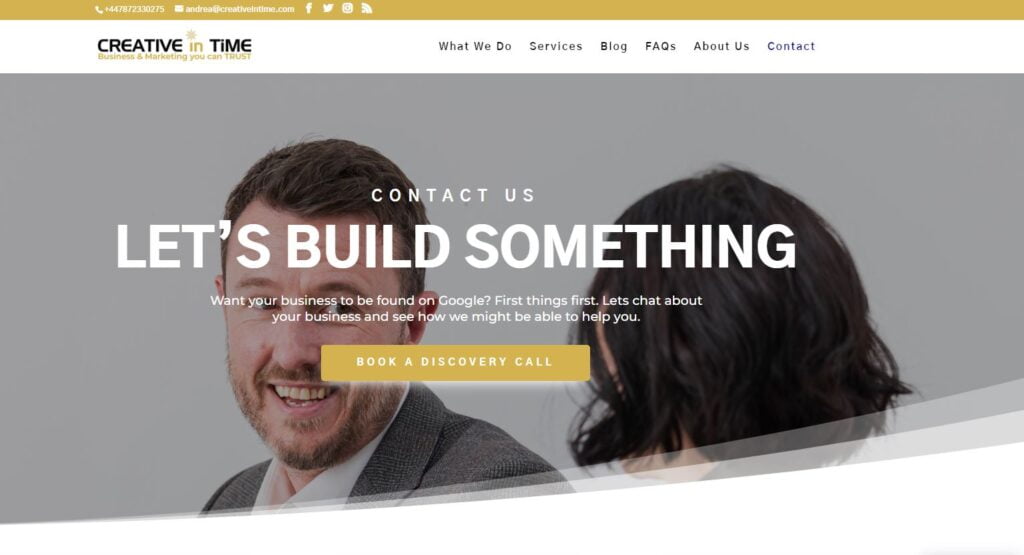What’s the point in spending days on a great marketing strategy if your customers struggle to get through to your or reach you?
Whether buying your product, booking a service or contacting your business, your customers should be able to do this easily. An overcomplicated user experience does not work for anyone!
A call to action could be your saving grace!
What is a Call to Action?
A call to action, or a CTA, is a way to guide your audience to where they need to go to generate a new lead. It’s like you giving your user direction, or a map to follow on their journey in converting.
It is a commonly used term in marketing, so this isn’t the last you’ll hear of them, and it is vital that you understand why they are so important!

See the coloured button saying, ‘Book A Discovery Call’? That’s an example of a call to action! The text before tells you what you need – to be found on Google – and how to get that by booking a discovery call with CREATIVE in TiME.
A call to action could lead the user to:
- Click on your website
- Subscribe to a newsletter
- Buy directly from your store
- Get in touch with you via phone, email or contact form
- Follow your social channels
Why Do You Need a Call to Action?
Call to action links and buttons act as digital signposts for your users. Using the map analogy again, when you’re travelling you will know your desired destination, but you will still need a map or guidance to get from Point A to Point B.
A call to action is exactly that – it explicitly shows the user where they need to go from here. They’ve landed on your site or ad, so where do you want them to go next?
If it is too difficult to navigate, they may end up leaving your website all together!
CTA A/B Testing
A call to action (CTA) is the perfect opportunity for A/B testing!
CTA A/B testing is when you run two options in conjunction with one another. You then compare the data from test A and test B to know which direction to take based on the performance.
Call to actions offer a prime opportunity to test which one is more effective at the same time. Why waste time later when you could save it right now?
The words and appearance of your content have a direct impact on your conversion rate.
For example, some people will not connect with the term “free trial” or “subscribe” but will resonate better with “learn more” or “try our product today”. Same end goal, different approach.
This is because the trial and subscribe angle can show commitment and your audience might not be ready to commit yet. But, some users, love freebies and will jump on the word “free trial”.
It all depends on your specific target audience!
Understanding Call to Actions (CTA)
Call to Actions on Your Website
Call to actions on your website help to build internal links to your other pages.
By using call to actions as a form of link building, you can direct your user to where they need to go in order to buy, sign up or call your business.
For a website, it is best practice to have your call to actions spread out throughout the content.
There is usually a call to action in line with the header on eCommerce sites since the user typically already knows what they want when they land on the page.
Call to Actions on Paid Ads
Call to actions on paid ads usually link to the company website when it comes to paid search engine ads. Even on paid social ads, this is the most common link you see.
With search engine ads, you can often be limited in your character count, and when each one counts, you need to make sure that people know where they are going from here and what they are going to get out of it.
Your CTA is important but so is the lead up to it – the selling points before the user clicks on your link.
Having a call to action saying: “Get in Touch”, for example, is effective but your user needs to know exactly why. Why should they contact you? What do they get out of it? Why choose you over your competitors? Making sure your user understands the value of clicking on your CTA is vital to boost its performance.
Call to Actions on Social Media
Depending on the platform, call to actions on social media vary. They serve the same purpose in driving your users to your intended destination.
On Instagram, the most common one is to visit a link in the profile’s bio since links are not clickable on individual posts. But if your goal is to attract new followers, Instagram provides you with a CTA. When you go on your explore page, a follow button appears on the right-hand side of posts.
So, your job is easy, just creating enticing graphics and write engaging content! That’s not actually easy at all. Check out our blog on social media strategies here or get in touch with CREATIVE in TiME for a bespoke social media strategy, after all, CTAs are important across your whole marketing strategy.
On LinkedIn, we have found that links work best when they are at the end of the post. With LinkedIn, we find that we spend as much time on our above the fold content (the bit you see before clicking ‘see more’) as we do with the rest of our content. It must be enticing otherwise they’d never see the link!
Effective Call to Action Examples
For a call to action to work, it should be obvious in where to go next as well as being in line with your overall marketing message.
Personalised Call to Actions
Did you know that personalised call to actions perform 202% better than basic CTAs?
That’s because personalisation is always a hit! We all know that marketing isn’t personal and that marketers are targeting large groups rather than a select group of individuals. But it doesn’t have to feel that way.
In emails for example, you can have it swap out the name to the addressee – as long as their name is in the email contact information. Are you more likely to click on a more personalised call to action?
Subscribe
Users subscribe to newsletters or social channels mostly to gain information. If you are an expert in your industry, you can send out the educational pieces your users are looking for directly to them ensuring you are always at the forefront of their mind.
Not everyone in your audience will want to subscribe to a newsletter or service however, so understanding your audience needs is imperative to make sure you are reaching out in the best way.
Learn More
You will have enticed them in the copy before this with a hook that draws them in. When your audience sees that they can learn more about this, they will want to click onto your site.
It can also create a good flow through your website to bring users on an experience leading them to your goal.
Weak Call to Action Examples
Click Here
Whilst this could be attached to other text, it doesn’t tell your audience directly what they are clicking for. Are they being sent to a website? Social channel? A sign-up form? They simply don’t know.
Examples above such as ‘Subscribe’ inform your audience what they are clicking for in a more direct approach.
Do You Want to Know More?
Call to actions like these aren’t clear on where your audience should go next. Good call to action’s need to give clear instructions to the audience on their next point of action.
Try Our Free Trial
Most of the time, discounts jump out to users – especially when they are free. But that isn’t always the case. Actually, it can deter other users from converting because some free trials require you to register your bank details. You don’t want to know how often people sign up for free trials, forget, and get charged!
Where To Place Call to Actions?
Well that entirely depends on your channel!
It is proven that call to action buttons placed towards the end of your content or right at the top outperform other CTAs. But when it comes to website copy, having them spread out all over the page (not too many though!) provides a better experience for the user.
They don’t have to scroll all the way to the top or the bottom, they can click the CTA button in the exact moment they are ready to convert.
How CREATIVE in TiME Use Effective Call to Actions
CREATIVE in TiME work in all areas of content marketing, meaning we use call to actions on a daily basis. How many can you spot on our homepage?
With our years of experience, we have trialled new innovative ways to incorporate call to actions in all our channels. We know what has a history of working and have never worked for us.
Get in touch with CREATIVE in TiME today for all your content needs! All content needs a CTA, after all!




0 Comments